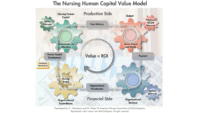To: Ethics Advisory Board
From: ANA member
Subject: Nurses’ well-being
I was a senior in my bachelor of science in nursing program last year during COVID-19 when there were challenges for clinical rotations at our healthcare practice sites. Now my coworkers and I are experiencing stress and anxiety related to caring for patients with COVID-19 and the accompanying long hours, makeshift units, and family demands. Does the American Nurses Association (ANA) offer resources that would help us address these issues, improve our health and well-being, and enhance the health outcomes of our patients?
From: ANA Center for Ethics and Human Rights
ANA is concerned with nurses’ well-being because promoting a healthy work environment improves job satisfaction, retention, safety, and quality of patient care. The ANA position statement, “Addressing nurse fatigue to promote safety and health” (bit.ly/3iTLJ6t), states that “registered nurses and employers in all care settings must collaborate to reduce the risk of nurse fatigue and sleepiness associated with shift work and long hours.” ANA further explains that it’s the “responsibility of the employer to promote a culture of safety and a healthy work environment to reduce the risk for job stress and the potential for negative outcomes associated with fatigue.” The Joint Commission reported that “an emerging method to do this is by developing and fostering resilient environments and individuals.” Research by McCann and colleagues examined the development of these types of environments to reduce negative, and increase positive, outcomes of stress for health professionals.
The Code of Ethics for Nurses with Interpretive Statements (the Code, nursingworld.org/coe-view-only) states that “fatigue and compassion fatigue affect a nurse’s professional performance and personal life. To mitigate these effects, nurses should eat a healthy diet, exercise, get sufficient rest, maintain family and personal relations, engage in adequate leisure and recreational activities, and attend to spiritual or religious needs.” In addition, the Code (5.2) states that “nurses in all roles should seek this balance, and it is the responsibility of nurse leaders to foster this balance within their organizations.”
Strategies for nurse well-being include programs such as the ANA Enterprise Healthy Nurse, Healthy NationTM (hnhn.org), a national initiative to improve the health of the country’s 4.2 million RNs. HNHN includes resources such as a health risk appraisal and other tools to address physical activity, rest, nutrition, quality of life, and safety. Monthly challenges focus on different topic areas and offer daily tips or suggestions for RNs to consider.
Additionally, the Well-Being Initiative (nursingworld.org/thewellbeinginitiative), launched by the American Nurses Foundation, offers free tools and apps to support the mental health and resilience of all nurses. Among other resources, visitors can access podcasts with nurses discussing coping mechanisms, take a stress self-assessment, connect with compassionate listeners to talk about self-care and wellness, and participate in an expressive writing program.
Dzau, Kirch, and Nasca proposed that healthcare systems should promote clinicians’ well-being within organizations through activities such as integrating the work of chief wellness officers, ensuring psychological safety, and developing well-being programs. These authors also recommended allocating federal funding for mental health support and epidemiological tracking programs to report on intervention outcomes.
— Response by Teri Chenot, EdD, MS, MEd, MSN, RN, CCE(ACBE),
FAAN, FNAP, member of the ANA Center for Ethics and
Human Rights Advisory Board.
References
The Joint Commission. Quick Safety: Developing resilience to combat nurse burnout. July 2019. jointcommission.org/-/media/tjc/newsletters/quick_safety_nurse_resilience_final_7_19_19pdf.pdf.
McCann CM, Beddoe E, McCormick K, et al. Resilience in the health professions: A review of recent literature. Int J Wellbeing. 2013;3:60-81. doi:10.5502/ijw.v3i1.4
Dzau VJ, Kirch D, Nasca T. Preventing a parallel epidemic—A national strategy to protect clinicians’ well-being. N Engl J Med. 2020;383(6):513-5. doi:10.1056/NEJMp2011027

















